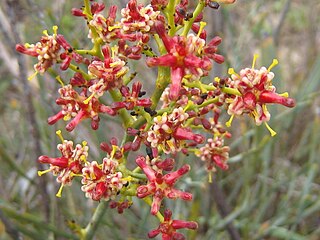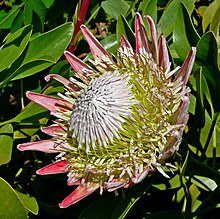
Knightia is a small genus of the family Proteaceae endemic to New Zealand, named in honor of Thomas Andrew Knight. One extant species, K. excelsa (rewarewa) is found in New Zealand. Two further Knightia species are found in New Caledonia, although they were placed in the genus Eucarpha by Lawrie Johnson and Barbara Briggs in their influential 1975 monograph "On the Proteaceae: the evolution and classification of a southern family", a placement supported in a 2006 classification of the Proteaceae. A fossil species from upper Miocene deposits in Kaikorai has been described as Knightia oblonga. Knightia has been placed in the tribe Roupaleae of the subfamily Grevilleoideae.

Xylomelum is a genus of six species of flowering plants, often commonly known as woody pears, in the family Proteaceae and are endemic to Australia. Plants in this genus are tall shrubs or small trees with leaves arranged in opposite pairs, relatively small flowers arranged in spike-like groups, and the fruit a woody, more or less pear-shaped follicle.

Adenanthos is a genus of Australian native shrubs in the flowering plant family Proteaceae. Variable in habit and leaf shape, it is the only genus in the family where solitary flowers are the norm. It was discovered in 1791, and formally published by Jacques Labillardière in 1805. The type species is Adenanthos cuneatus, and 33 species are recognised. The genus is placed in subfamily Proteoideae, and is held to be most closely related to several South African genera.

As with other flowering plants, the taxonomy of Banksia has traditionally been based on anatomical and morphological properties of the Banksia flower, fruiting structure and seed, along with secondary characteristics such as leaf structure and growth habit. Increasingly, molecular evidence from DNA is providing important new insights into relationships within the genus and between this and other genera in the Proteaceae.

The Proteaceae form a family of flowering plants predominantly distributed in the Southern Hemisphere. The family comprises 83 genera with about 1,660 known species. Australia and South Africa have the greatest concentrations of diversity. Together with the Platanaceae, Nelumbonaceae and in the recent APG IV system the Sabiaceae, they make up the order Proteales. Well-known Proteaceae genera include Protea, Banksia, Embothrium, Grevillea, Hakea, and Macadamia. Species such as the New South Wales waratah, king protea, and various species of Banksia, Grevillea, and Leucadendron are popular cut flowers. The nuts of Macadamia integrifolia are widely grown commercially and consumed, as are those of Gevuina avellana on a smaller scale.

The Grevilleoideae are a subfamily of the plant family Proteaceae. Mainly restricted to the Southern Hemisphere, it contains around 46 genera and about 950 species. Genera include Banksia, Grevillea, and Macadamia.

Triunia is a genus of medium to tall shrubs or small trees found as understorey plants in rainforests of eastern Australia. Members of the plant family Proteaceae, they are notable for their poisonous fleshy fruits or drupes. Only one species, T. youngiana, is commonly seen in cultivation.

Buckinghamia is a genus of only two known species of trees, belonging to the plant family Proteaceae. They are endemic to the rainforests of the wet tropics region of north eastern Queensland, Australia. The ivory curl flower, B. celsissima, is the well known, popular and widely cultivated species in gardens and parks, in eastern and southern mainland Australia, and additionally as street trees north from about Brisbane. The second species, B. ferruginiflora, was only recently described in 1988.

Roupala is a Neotropical genus of woody shrubs and trees in the plant family Proteaceae. Its 34 species are generally found in forests from sea level to 4000 m altitude from Mexico to Argentina.

Stirlingia, commonly known as blueboy, is a genus of 7 species in the family Proteaceae, all of which are endemic to Western Australia.
On the Proteaceae: The Evolution and Classification of a Southern Family is a highly influential monograph on the evolution, biogeography and taxonomy of the flowering plant family Proteaceae. Authored by Lawrie Johnson and Barbara Briggs, it appeared in Volume 70 of Botanical Journal of the Linnean Society in 1975. Johnson and Briggs had presented what would become the paper at a meeting of the Linnaean Society on 6 December 1973 amid celebrations of 200 years since the birth of Robert Brown.

Protea roupelliae is a species of Protea in the large family Proteaceae, and was named to commemorate Arabella Elizabeth Roupell (1817-1914) who spent two years in Cape Town and painted local flowers for her own pleasure. This species is also known as the silver sugarbush.

Agastachys odorata, commonly known as the white waratah or fragrant candlebush, is the sole member of the genus Agastachys in the protea family. It is an evergreen shrub to small tree and is endemic to the heaths and buttongrass sedgelands of western Tasmania.

Cenarrhenes is a monytypic genus in the family Proteaceae containing the single species Cenarrhenes nitida, known as the Port Arthur plum or native plum. Cenarrhenes nitida is an evergreen shrub to small tree endemic to the rainforests and scrublands of western Tasmania. It bears white flowers in late spring followed by the development of fleshy fruit.

Darlingia ferruginea, commonly known as the brown silky oak, is a rainforest tree of the family Proteaceae from Northern Queensland.
Neorites is a monotypic genus of plants in the family Proteaceae. The sole species Neorites kevedianus, commonly called fishtail oak or fishtail silky oak, is a tall tree endemic to the wet tropics rainforests of north eastern Queensland, Australia.
Hollandaea is a small genus of plants in the family Proteaceae containing four species of Australian rainforest trees. All four species are endemic to restricted areas of the Wet Tropics of northeast Queensland.

Placospermum is a genus of a single species of large trees, constituting part of the plant family Proteaceae. The species Placospermum coriaceum is endemic to the rainforests of the wet tropics region of northeastern Queensland, Australia. Common names include rose silky oak and plate-seeded oak.
Eucarpha is a genus of flowering plant of the family Proteaceae, endemic to New Caledonia. Two species are recognised. Up to 1975, these were classified within the genus Knightia until Lawrence Johnson and Barbara G. Briggs recognised their distinctness, particularly their prominent bracts, in their 1975 monograph "On the Proteaceae: the evolution and classification of a southern family". Nomenclatural combinations for these two species in the genus Eucarpha were published in 2022.

Toronia is a genus of tree in the family Proteaceae that contains a single species, Toronia toru, which is endemic to New Zealand. The genus is closely related to the large genus Persoonia, and in fact this species was long regarded as one until placed in its own new genus by Lawrie Johnson and Barbara G. Briggs in their 1975 monograph "On the Proteaceae: the evolution and classification of a southern family".

















